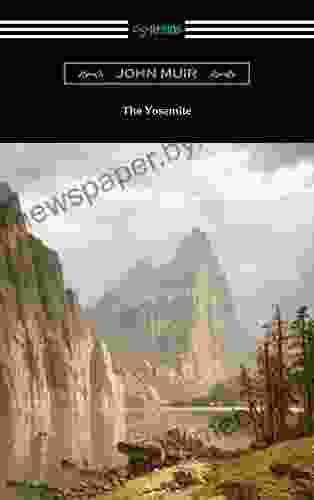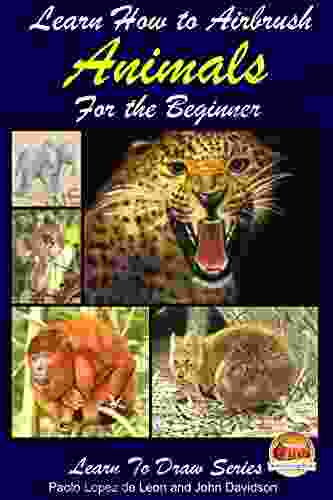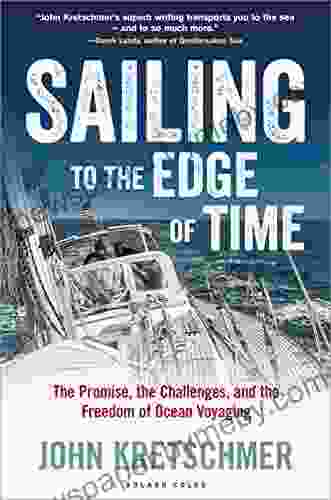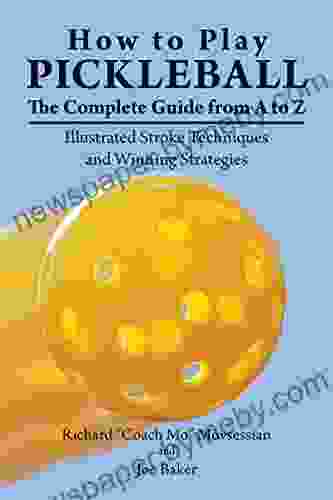Learn How To Airbrush Animals for Beginners Like a Pro

Are you ready to embark on an exciting journey of artistic exploration and bring your animal paintings to life with stunning realism? Airbrushing is an incredible technique that allows you to create breathtakingly realistic animal portraits and wildlife scenes that will leave you in awe.
If you're a beginner eager to master the art of airbrushing animals, you've come to the right place. This comprehensive guide will provide you with everything you need to know, from choosing the right equipment and materials to executing complex painting techniques.
4 out of 5
| Language | : | English |
| File size | : | 9477 KB |
| Text-to-Speech | : | Enabled |
| Screen Reader | : | Supported |
| Enhanced typesetting | : | Enabled |
| Print length | : | 128 pages |
| Lending | : | Enabled |
Chapter 1: Equipment and Materials for Airbrushing Animals
Before you dive into the world of airbrushing, it's essential to gather the right tools and materials. Here's what you'll need:
- Airbrush: Choose a high-quality airbrush that is specifically designed for fine art applications. This will ensure precise control and smooth paint flow.
- Air Compressor: Invest in a compressor that provides consistent air pressure for optimal performance.
- Paints: Use acrylic or water-based paints formulated for airbrushing. These paints offer excellent coverage and vibrancy.
- Canvas or Paper: Select a sturdy and high-quality surface that can withstand the force of the airbrush.
- Masking Tape: This tape will help you create sharp edges and protect certain areas of your painting.
- Stencils: Use stencils to add intricate details or patterns to your animal paintings.
Chapter 2: Basic Airbrushing Techniques
Now that you have your equipment ready, let's explore the fundamental airbrushing techniques:
- Holding the Airbrush: Grip the airbrush comfortably, perpendicular to the surface you're painting, and maintain a consistent distance.
- Controlling Airflow: Use the trigger to control the flow of air, which in turn determines the width and intensity of your paint strokes.
- Stroking: Practice smooth, even strokes and avoid jerky movements. Keep your wrist relaxed and let the airbrush glide effortlessly across the surface.
- Layering: Apply multiple layers of paint to build up depth and texture. Start with lighter shades and gradually transition to darker tones.
- Blending: Use the airbrush to soften transitions between colors by varying the air pressure and paint flow.
Chapter 3: Airbrushing Animal Portraits
Ready to bring your furry friends to life? Follow these steps for airbrushing stunning animal portraits:
- Sketch the Outline: Lightly sketch the animal's features and proportions onto the canvas.
- Block in the Base Color: Apply a thin layer of the animal's base color to cover the sketch.
- Define the Eyes: Use a small brush to add the eyes and pupillary details.
- Shape the Features: Use shading and highlights to define the animal's muzzle, nose, ears, and fur texture.
- Add Details: Bring your painting to life by adding whiskers, eyelashes, and any other intricate details.
Chapter 4: Airbrushing Wildlife Scenes
Capture the beauty of nature with airbrushing wildlife scenes:
- Create the Background: Use the airbrush to create a realistic background, whether it's a forest, meadow, or sky.
- Paint the Animals: Airbrush the animals into the scene, paying attention to their proportions, postures, and interactions.
- Add Vegetation: Use stencils or freehand airbrushing to create trees, grass, and other vegetation.
- Enhance with Details: Incorporate elements like water, rocks, or sunlight to add depth and realism to your scene.
Chapter 5: Troubleshooting and Tips for Beginners
Don't let setbacks discourage you! Here are some common troubleshooting tips:
- Clogged Airbrush: Clean your airbrush regularly to prevent paint buildup and ensure smooth operation.
- Uneven Paint Flow: Check the air pressure and adjust it accordingly. Also, make sure your paint is properly diluted.
- Blurry Lines: Hold the airbrush at a consistent distance from the surface and practice your stroke control.
- Grainy Texture: Use finer paint pigments and avoid overspraying.
Additional Tips:
- Start with simple animal subjects and gradually increase complexity as you gain confidence.
- Practice regularly to improve your hand-eye coordination and airbrush control.
- Don't be afraid to experiment with different techniques and find what works best for you.
- Use references and photos to capture the details and proportions of your animal subjects.
- Protect your work with a clear sealant to preserve its vibrancy and longevity.
Congratulations! You've now embarked on the exciting journey of airbrushing animals. With patience, practice, and these invaluable tips, you'll soon be creating breathtakingly realistic paintings that will impress fellow artists and art enthusiasts alike.
Remember, the true beauty of airbrushing lies in the subtle nuances and details that bring your animal subjects to life. As you continue your artistic exploration, you'll discover endless possibilities for expressing your creativity and capturing the essence of the animal kingdom with your own unique style.
So, embrace your inner artist, pick up your airbrush, and let the magic of animal airbrushing transform your canvases into vibrant and lifelike masterpieces!
4 out of 5
| Language | : | English |
| File size | : | 9477 KB |
| Text-to-Speech | : | Enabled |
| Screen Reader | : | Supported |
| Enhanced typesetting | : | Enabled |
| Print length | : | 128 pages |
| Lending | : | Enabled |
Do you want to contribute by writing guest posts on this blog?
Please contact us and send us a resume of previous articles that you have written.
 Book
Book Novel
Novel Page
Page Chapter
Chapter Text
Text Story
Story Genre
Genre Reader
Reader Library
Library Paperback
Paperback E-book
E-book Magazine
Magazine Newspaper
Newspaper Paragraph
Paragraph Sentence
Sentence Bookmark
Bookmark Shelf
Shelf Glossary
Glossary Bibliography
Bibliography Foreword
Foreword Preface
Preface Synopsis
Synopsis Annotation
Annotation Footnote
Footnote Manuscript
Manuscript Scroll
Scroll Codex
Codex Tome
Tome Bestseller
Bestseller Classics
Classics Library card
Library card Narrative
Narrative Biography
Biography Autobiography
Autobiography Memoir
Memoir Reference
Reference Encyclopedia
Encyclopedia Joe Flood
Joe Flood Joe Clifford
Joe Clifford Joseph Lanzara
Joseph Lanzara John G Hemry
John G Hemry Tim Learn
Tim Learn Richard S Newman
Richard S Newman Joanne Jamrosz
Joanne Jamrosz John C Yungjohann
John C Yungjohann Louisa J Morgan
Louisa J Morgan William Spencer
William Spencer Ronald Bergan
Ronald Bergan John Hopkins
John Hopkins Joe Darger
Joe Darger Thomas Hill
Thomas Hill John Matusiak
John Matusiak Jo Wimpenny
Jo Wimpenny Joey London
Joey London Scott Meyers
Scott Meyers Jim Rearden
Jim Rearden Jim Holt
Jim Holt
Light bulbAdvertise smarter! Our strategic ad space ensures maximum exposure. Reserve your spot today!

 Howard PowellSoar into Adventure: A Comprehensive Guide to Paper Airplane Mastery for Kids
Howard PowellSoar into Adventure: A Comprehensive Guide to Paper Airplane Mastery for Kids Todd TurnerFollow ·19k
Todd TurnerFollow ·19k Nathaniel HawthorneFollow ·5.7k
Nathaniel HawthorneFollow ·5.7k E.E. CummingsFollow ·6.6k
E.E. CummingsFollow ·6.6k Robert BrowningFollow ·2.2k
Robert BrowningFollow ·2.2k Dennis HayesFollow ·19.5k
Dennis HayesFollow ·19.5k Will WardFollow ·17.6k
Will WardFollow ·17.6k Gilbert CoxFollow ·3.6k
Gilbert CoxFollow ·3.6k Victor TurnerFollow ·7.3k
Victor TurnerFollow ·7.3k

 Jermaine Powell
Jermaine PowellThe Ultimate Guide to Unlocking Consistent Profitable...
Introducing the 2nd Edition of the...

 Yasunari Kawabata
Yasunari KawabataMinute Microskills Videos: The Ultimate Guide for Visual...
Unlock Your Potential with Bite-Sized Video...

 Nathan Reed
Nathan ReedUnveiling the Wonders of Yosemite through John Muir's...
Immerse yourself in the breathtaking beauty...

 Gabriel Garcia Marquez
Gabriel Garcia MarquezWhen You Find Me Novel: A Gripping Mystery Unravels
In the sleepy...

 Esteban Cox
Esteban CoxMountains of California: An Essential History of...
From the towering...

 Devin Ross
Devin RossComm Check: Unveiling the Heartbreaking Final Flight of...
Comm Check: The Final Flight of Shuttle...
4 out of 5
| Language | : | English |
| File size | : | 9477 KB |
| Text-to-Speech | : | Enabled |
| Screen Reader | : | Supported |
| Enhanced typesetting | : | Enabled |
| Print length | : | 128 pages |
| Lending | : | Enabled |










